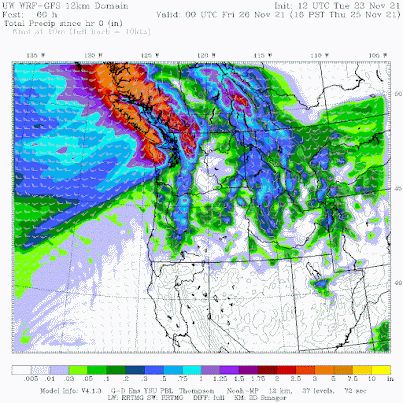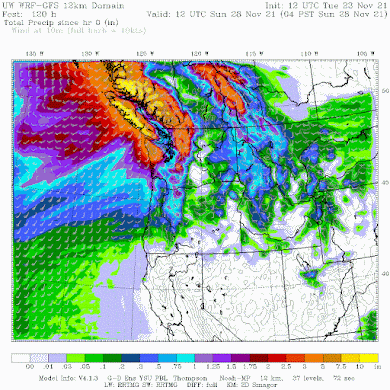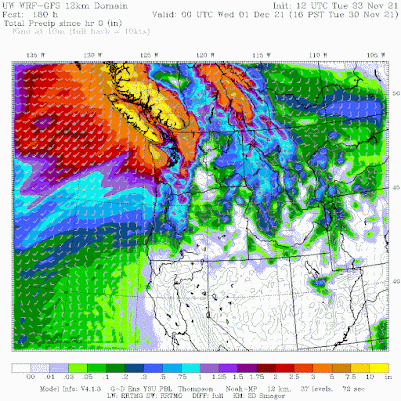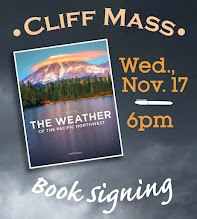Last weekend there were highly damaging floods over Northwest Washington, with the town of Sumas and its vicinity being inundated by floodwaters. Several landslides occurred, including some that closed I5 near Bellingham.
Town of Sumas, 2021, WSDOT Photo
Within hours of this heavy rainfall event, politicians and the media were suggesting that this event was somehow unique and the result of global warming.
For example, Governor Inslee called the flooding an example of “a permanent state of attack by the forces of climate change.” The New York Times claimed that flooding in Northwest Washington was caused by climate change (see below)
Similar claims were found in the Washington Post and the Guardian. And, of course, the Seattle Times had several stories, supported by a slew of "experts" (such as a Simon Fraser Professor) stating that climate change contributed to the flooding. The truth is very different than these claims. The Sumas area is extraordinarily prone to flooding and has experienced flooding many times before. And as I will demonstrate below, there is no evidence whatsoever that global warming caused the heavy rainfall associated with this event.
A Flood-Prone Region
The town of Sumas is within the historical flood plain of the Fraser River, with an additional flooding threat from local rivers such as the Nooksack (see maps below from a 2005 report by Dr. Jacek Scibek and Dr. Diana Allen of Simon Fraser University)
Importantly there was a large historic lake near Sumas and Abbotsford (Sumas Lake) that was drained for use in agriculture. In short, a low-lying, historically wet area that has always been prone to flooding.
Previous Flooding
Flooding is not a new visitor to the Sumas area, which has experienced flooding many times during the past century. The streets of Sumas was similarly flooded in February 2020 (see below)
And there were many previous major floods, including those in 1990 and 1951, to name only a few (see some more examples from the Whatcom County analysis of flooding events). You build a town in a historical river delta in one of the wettest portions of North American, you can expect trouble.
To say that flooding in Sumas or the region is something new, unprecedented, or unique is simply not correct. Those making such claims should have spent a little time examining historical floods of the region..
Global Warming And Heavy Precipitation
There has been a LOT of handwaving about the heavy precipitation during this event, claiming it was the result of global warming. Or that it was greatly enhanced by global warming.
Yes, we had a major rainfall event, but to make a claim that global warming was the origin, it is necessary to demonstrate that there has been a progressive increase in heavy rain, something that would be a sign of a global warming origin.
Let's look at the data. Karin Bumbaco, Associate Washington State Climatologist, graciously provided me with plots of annual maximum 24-h rainfall at Bellingham, WA, and at the nearby Clearbrook official climatological observing site, with the latter having a very long record (see below).
There is NO HINT of a trend towards more extreme precipitation at either of these sites. According to Karin, the big peak in the mid-1930s was from an error in putting two days of rainfall into one day.
Such a lack of evidence of global warming is consistent with state-of-science regional climate modeling, which found that climate models (driven by very aggressive increases in greenhouse gas emissions (RCP8.5) did not produce significant increases in 24-h maximum precipitation in the area over the past half-century (results for Bellingham is shown below). By the END of the century (not shown here), aggressive global warming will increase the heaviest precipitation...but that is in the future.
But wait! There is even more evidence against a global warming contribution to this localized heavy precipitation event.
The origin of this event was a moderate atmospheric river, in which a narrow plume of water vapor was forced upward by our local mountains (see plot of water vapor at 4 PM last Sunday).
If global warming was important, then one would look for above-normal sea surface temperatures along the atmospheric river's path, which would provide additional moisture to the air.
Below are the sea surface temperature anomalies (differences from normal) for the period leading up and including the atmospheric river in question. It was cooler than normal immediately off our coast and near normal for virtually the entire path of the atmospheric river. With La Nina conditions, the water temperatures near the equator were BELOW normal. No sign of a global warming contribution.
Forest Fires Did Not Contribute to the Flooding
In desperation, some of the global warming advocates are suggesting, without a shred of evidence, that the forest fires from last summer were contributing to the flooding. Specifically, they claim that debris from the fires and less absorptive capacity of the burned landscapes resulted in more water and material entering the rivers.
We can see how much of the land immediately around the flooding areas was burnt using NASA MODIS imagery (see below for October 31st, when it was clear). Recently burned landscapes have a reddish hue (I have indicated an example of a recent fire, east of the Cascade crest, with a red arrow.
It is obvious that there are no major burnt areas around the flooding area or the associated river basins that received heavy precipitation during this event. So wildfire burnt areas did not make a contribution to these fires.
Snowpack
Another claim, as found in the New York Times, was that there was low snowpack (due to global warming) before the flood, leading to a reduced capacity to soak up the rainwater. But that was not true: the snowpack was well above normal prior to the event (USDA Snotel map a few days before the flood is shown below). The snowpack was well above normal.....not exactly the kind of situation associated with global warming. I mean MUCH above normal.
I should note that melting snow probably had little impact on this flooding event. There are several papers (such as
this one) that documents that rain on snow melting is very small compared to the rainfall itself. Furthermore, there was little low-elevation snow before this event, which would be the most likely to contribute.
Epilogue
It is both concerning and problematic that some local politicians, local and national media, and even some scientists are willing to stretch the truth about the origins of this serious flooding event, suggesting a major contribution from global warming (frequently called "climate change".
Society can not effectively deal with environmental threats when it is provided with hyped or false information. And providing such false information, even in the hope of motivating people to "do the right thing", has substantial ethical problems.
























































